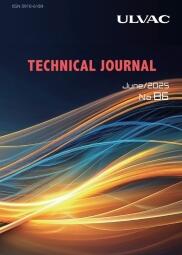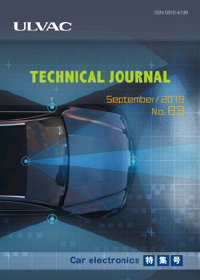テクニカルジャーナル
Technical Journalは、技術開発型企業アルバックならではの技術者独自のレポートを紹介しているアルバックグループの技術情報誌です。
購読いただくにはお客様登録(無料)が必要となります。お客様情報をご入力・送信後、ダウンロードいただけます。
ファイルをダウンロードしたい方はこちらからフォーム入力をお願いいたします。

No.86
June/2025
-
真空蒸着プロセスを用いた全固体電池向け修飾層つきLi金属負極の開発ダウンロード(株)アルバック 木本孝仁 他
All-Solid-State Batteries (ASSB) are composed of entirely solid materials and have an extremely low risk of ignition and higher safety than conventional lithium-ion batteries. In addition, all-solid-state lithium metal batteries, which use lithium metal as the anode material, are attracting attention as batteries that can achieve an energy density that surpasses conventional lithium-ion batteries. In this study, Li metal anode with a modified layer for the sulfide-based all-solid-state electrolyte was investigated using a vacuum deposition process. "Mg" was selected as the modified layer, and results show that a great ASSB performance was successfully achieved.
-
生体組織の円偏光分析による高度病理情報取得を目指した基礎研究ダウンロード(株)アルバック 戸田晋太郎 他
Non-invasive diagnosis using Circularly Polarized Light (CPL) is a promising next-generation medical technology. In this work, the visible CPL characteristics of human lung adenocarcinoma were evaluated. White CPL was incident to cultured cell samples( normal and cancerous) and sliced tissue samples (non-metastatic and metastatic cases), and the polarization state of the transmitted light was analyzed by the polarizer rotation method. As a result, the depolarization ratio and its Circular Dichroism(CD) are larger in the cancer cells( or tumor region) than in the normal ones in any samples. In addition, there is the gap of differences in the CD between the normal and tumor region in each non-metastatic and metastatic sliced tissue samples. These findings suggest that polarization parameters may be applicable to distinguishing between normal and cancerous cells( or tumor region) and to evaluating the malignancy of cancer.
-
磁気スキルミオンブラウニアン素子の開発ダウンロード(株)アルバック 石川諒 他
Magnetic skyrmions are vortex-like spin textures that are stabilized due to topological protection and exhibit Brownian motion in solids. Owing to the high applicability of skyrmions in Brownian motion as an information carrier, it is expected to be applied to unconventional computers such as probabilistic and Brownian computing. Some work on how to control the Brownian motion of skyrmions is introduced in this manuscript.
-
電子デバイス向け誘電体エッチングモジュールダウンロード(株)アルバック 中村敏幸 他
We have developed a dielectric material etching module capable of processing wafers up to 8 inches for electronic device manufacturing lines. That is a narrow-gap capacitively coupled plasma etching module using a 400 kHz high-frequency power supply, specifically designed for etching dielectric materials with fluorocarbon-based process gases. It features excellent etching uniformity, less metal contamination, and fewer particles, with optimized components such as single-crystal silicon parts, ceramic electrostatic chuck, and an isotropic exhaust structure.
-
革新的技術で切り拓くフルオート多機能走査操作型XPS装置の分析事例ダウンロードアルバック・ファイ(株) 橋本真希 他
In recent years, with the advancement of high-performance materials, the structures of devices combining these materials have become increasingly complex. Particularly, the analysis of material interfaces, which play a critical role in device functionality, has gained significant importance. X-ray Photoelectron Spectroscopy( XPS), as a surface analysis technique, has become indispensable. XPS enables precise measurement of the chemical states and elemental concentrations of material surfaces and is widely utilized in the development of battery and semiconductor materials. This article introduces the features and applications of the fully automated, multifunctional XPS system "PHI GENESIS".

No.85
March/2023
-
uGmniシリーズエッチングモジュール向け新誘導結合プラズマ源「ISM-duo」ダウンロード(株)アルバック 土居謙太 他
Our new plasma source "ISM-duo" enables the across-wafer etching rate uniformity of our uGmni etching module to be controlled. ISM-duo consists of an RF current distribution unit and two separate ICP antennas placed coaxially so as to control the spatial distribution of plasma generated in the process chamber. The RF current distribution to each antenna is performed at an arbitrary ratio without depending on process parameters such as gas type, and changing the distribution ratio does not disturb impedance matching. These features enable a stable operation of the etching rate uniformity control through the optimization of the RF current distribution ratio for various processes. ISM-duo delivers a new process tuning knob that enlarges the process window in our etching module.
当社の新しいプラズマソース「ISM-duo」は、化合物半導体やパワーデバイス、圧電膜向けにuGmniエッチングモジュールにおけるウエハ全体のエッチングレート均一性制御を可能にする。ISM-duoは、RF電流分配ユニットと、プロセスチャンバー内で生成されるプラズマの空間分布を制御するために同軸上に配置された2つの独立した誘導結合プラズマ(Inductively Coupled Plasma, ICP)アンテナで構成されており、低圧かつ低電子温度で高密度なプラズマを生成できる。各アンテナへのRF電流分配はガス種などのプロセスパラメータに依存せず、任意の比率で行われ、分配比率を変更してもインピーダンスマッチングが乱れることはない。これらの特徴により、各種プロセスに応じたRF電流分配比の最適化によるエッチングレート均一性制御を安定的に行うことができる。ISM-duoは、エッチングモジュールのプロセスウィンドウを拡大する新しいプロセスチューニングノブを提供する。
-
GaNエピタキシャル薄膜形成用スパッタリングモジュール「SEGul」の開発ダウンロード(株)アルバック 白井雅紀 他
We have developed the radical assist sputter epitaxy (RaSE) method to enable epitaxial growth of gallium nitride (GaN) by sputtering and the "SEGul" system for mass production. Compared to the metal organic chemical vapor deposition (MO-CVD) method, which is a common GaN film formation method, the RaSE method has the advantages of a low deposition temperature and a low material cost when forming epitaxial GaN thin films. The MO-CVD method uses organometallics and toxic gases such as NH₃ as raw materials at a formation temperature of about 1000℃. In contrast, the "RaSE" method uses common materials such as Ga, N₂, and Ar, and GaN formation can be performed at relatively low temperatures of 700℃ or lower. It can also be applied to the formation of high density n-type GaN thin films with n-type carrier density in the 1x1020 cm-3 range by using an additional sputtering source for doping. In this report, we describe the characteristics of GaN thin films formed by the RaSE method, as well as the mass production system "SEGul" which can handle up to 8-inch wafer sizes.
当社は、スパッタリングにより窒化ガリウム(GaN)をエピタキシャル成長させるラジカルアシストスパッタエピタキシー(Radical assist Sputter Epitaxy, RaSE)法と量産用装置「SEGul」を開発した。RaSE法は、一般的なGaN成膜法である有機金属気相成長法(MO-CVD)と比較して、エピタキシャルGaN薄膜を形成する際の成膜温度が低く、材料コストが安いという利点がある。MO-CVD法は、有機金属とNH₃などの有毒ガスを原料として使用し、約1000℃の温度で形成される。これに対し、「RaSE」法はGa、N2、Arといった一般的な材料を用い、700℃以下の比較的低温でGaNの形成が可能である。また、ドーピング用の追加のスパッタリング源を使用することにより、1×1020/cm3台のn型キャリア密度を有する高密度n型GaN薄膜の形成にも適用できるため、パワーデバイスである高電子移動度トランジスタ(High Electron Mobility Transistor, HEMT)としても開発が進められている。本稿では、RaSE法により形成されたGaN薄膜の特性と、最大8インチウェーハサイズまで対応可能な量産装置「SEGul」について紹介する。
-
OLEDデバイス向け低ダメージスパッタプロセスの開発ダウンロード(株)アルバック 松崎淳介 他
Organic light emitting diode (OLED) devices are applied to various displays such as smartphones, monitors, and TVs, but it is necessary to improve the cost and lifetime of such displays. Top emission type OLEDs have high light extraction efficiency but require higher transmission and lower resistance cathode electrodes, so we have developed a low damage sputtering process for these OLED devices.
Sputtering processes with high temperatures and lots of particles not only reduce device performance, but also reduce mass production yields. That is why ULVAC's sputtering process concepts for these OLED devices are "low damage," "low temperature," and "low particle."
In this paper, we analyzed the sputtering damage factor related to device performance and established a sputtering process that can reduce the damage factor. The drive voltage and efficiency of OLED devices using the low damage sputtering process was the same as that of the reference vapor deposition device, and the lifetime was more than 20% longer.有機発光ダイオード(OLED)デバイスはスマートフォン、モニター、テレビなどさまざまなディスプレイに応用されているが、ディスプレイのコストと寿命を改善する必要がある。トップエミッション型OLEDは高い光取り出し効率を有するが、より高い透過率とより低い抵抗のカソード電極を必要とする。従って、これらのOLEDデバイス向けに透明導電膜(Transparent Conductive Oxide, TCO)を用いた低ダメージスパッタリングプロセスを開発した。高温で大量の粒子を伴うスパッタリングプロセスは、デバイスの性能を低下させるだけでなく、量産歩留まりも低下させる。そこで、当社のOLEDデバイスのスパッタリングプロセスは「低ダメージ」、「低温」、「低パーティクル」をコンセプトとしている。本稿では、デバイス性能に関係するスパッタリングダメージ因子を解析し、ダメージ因子を低減できるスパッタリングプロセスを確立した。低ダメージスパッタリングプロセスを用いたOLEDデバイスの駆動電圧と効率は、リファレンスの蒸着を用いたデバイスと同等であり、寿命は20%以上長寿命化した。
-
腐食性ガスを用いる真空装置用表面処理「VACAL®-Z」の開発ダウンロード(株)アルバック 石榑文昭 他
We have developed a method of micro arc oxidation treatment (VACAL®-Z) as a surface treatment for aluminum alloy used in vacuum equipment using corrosive gases, such as CVD equipment. The oxide layer formed by VACAL®-Z had a three layer structure of crystalline γ-alumina. In addition, we have devised and made possible a step processing method for treating the entire surface of large objects, such as vacuum production equipment for flat panel displays, by VACAL®-Z.
当社は、Chemical Vapor Deposition(CVD)装置などの腐食性ガスを使用する真空装置に用いられるアルミニウム合金の表面処理として、マイクロアーク酸化処理(Micro Arc Oxidation, MAO)であるVACAL®-Zという方法を開発した。VACAL®-Zにより形成された酸化被膜は結晶性γ-アルミナの3層構造となっており、高い耐食性を有することから腐食性ガスから材料を守り、パーティクルの発生を低減することができる。また、フラットパネルディスプレイ(FPD)用真空製造装置などの大型物の全面処理をVACAL®-Zで行うステップ加工方法を考案し、大面積処理を可能とした。
-
HFガスを用いたSiO₂のバッチ式等方性ガスエッチング装置の開発ダウンロード(株)アルバック 橋本篤明 他
We have developed a new batch-type isotropic gas etching system that does not utilize H radicals. The isotropic gas etching process is used in semiconductor manufacturing to etch pattern structures and requires high aspect ratio etching without causing damage to the underlying layer. Our previous release, RISE-300, was a batch-type gas etching tool that utilized H radicals and was easy to handle due to the absence of highly corrosive gases like HF. However, it was difficult to control the etching distribution within each batch. In recent years, conventional processes have become insufficient to meet the performance requirements of device manufacturers. Our new batch-type isotropic gas etching process, which does not utilize H radicals, outperforms conventional methods in terms of wafer-to-wafer uniformity and step coverage. Additionally, this new process allows for precise control of etching distribution within the wafer plane.
水素ラジカルを使用しない新しいバッチタイプの等方性ガスエッチングシステムを開発した。等方性ガスエッチングプロセスは、3D NANDなどの半導体製造において高アスペクト比なパターン構造に対して基層への損傷を引き起こさずにエッチングすることが要求される。以前のリリースであるRISE-300は、水素ラジカルを使用したバッチタイプのガスエッチングツールであり、HFのような高腐食性のガスが不要のため取り扱いが容易であった。しかし、各バッチ内でのエッチング面内分布を制御することは困難であった。近年、従来のプロセスではデバイスメーカーの性能要件を満たすことが不十分となっている。水素ラジカルを使用しない我々の新しいバッチタイプの等方性ガスエッチングプロセスは、ウェハ間均一性とステップカバレッジの点で従来の方法を上回る性能を実現している。さらに、この新しいプロセスにより、ウェハ面内のエッチング分布を正確に制御することが可能となった。
-
22型クライオポンプの省エネ化ダウンロードアルバック・クライオ(株) 村山吉信 他
The size of glass substrates in organic light emitting diode (OLED) vapor deposition equipment has increased, the mainstream has changed from conventional G6H devices to G8H devices, and the vapor deposition equipment itself has also become larger. Therefore, cryopumps used as high vacuums pumps will also be increased in size from 20 inches to 22 inches, and pumping speed will increase. In this paper, we introduce the history of 22-inch cryopump development and a technology that realizes both cost reduction and energy saving in a cryopump system that will be adopted in the G8H in the future.
有機発光ダイオード(OLED)蒸着装置は、従来のG6HサイズからG8Hサイズへとガラス基板サイズの主流が変化して、蒸着装置自体も大型化していく。従って、高真空ポンプとして使用されるクライオポンプも20インチから22インチへと大型化し、排気速度も高速化が必要である。また、顧客需要としてさらなる低温運用が求められており、クライオポンプの再生周期を維持するには、冷凍機や排気性能の改善も必要である。本稿では、22インチクライオポンプの開発経緯および今後G8Hに採用されるクライオポンプシステムのコストダウンと省エネルギー化を両立する技術について紹介する。
-
有機EL製造装置の清浄性確保に向けたアルバックの取り組みダウンロード(株)アルバック 渡部純 他
The problem with organic light-emitting diode (OLED) displays is that their service lifetime is affected by impurities in vacuum equipment. Therefore, equipment manufacturers need to ensure the cleanliness of their equipment. We developed a technology to evaluate trace amounts of water-soluble impurities in vacuum equipment by using ion chromatography (IC). As a result, we established our own simple cleanliness evaluation technology.
By using this evaluation technology to monitor and take countermeasures against residual ions in the equipment during each process from manufacturing to delivery, we have been able to manufacture equipment with high cleanliness that meets the required quality.
In addition, we conducted device fabrication and service lifetime tests on OLED deposition equipment to evaluate the impact of equipment components on device lifetime. The evaluation of devices exposed to fluorinated resin-coated cables suggested that the factor causing service lifetime degradation was a gas containing C-F. Meanwhile, it was found that the devices can still be used as device components by reducing the amount of impurities through appropriate cleaning processes. We will contribute to further quality improvement of OLED production equipment by utilizing this technology.有機発光ダイオード(OLED)ディスプレイではデバイスの寿命が真空装置中の不純物によって影響を受けることが問題となる。従って、装置メーカーは装置の清浄性を確保する必要がある。真空装置中の微量水溶性不純物をイオンクロマトグラフィー(Ion Chromatography, IC)を用いて評価する技術を開発した。その結果、独自の簡易清浄度評価技術を確立した。この評価技術を用いて、製造から出荷までの各工程において装置内の残留イオンを監視・対策することで、要求品質を満たす清浄度の高い装置の製造を実現した。さらに、OLED蒸着装置のデバイス製造および寿命テストを実施し、装置のコンポーネントがデバイスの寿命に及ぼす影響を評価した。フッ素樹脂被覆ケーブルに曝露された機器の評価により、寿命低下の要因はC-Fを含むガスであることが示唆された。一方、適切な洗浄プロセスにより不純物の量を低減することで、部品として使用できることがわかった。当社は本技術を活用することで、OLED製造装置のさらなる品質向上に貢献する。
-
位相差調整による,絶縁膜の埋め込み成膜技術ダウンロード(株)アルバック 中畑俊彦 他
When radio frequency (RF) power sources are used on both the cathode and stage sides, effective stage bias can be achieved by controlling the RF phase. We found that this can be ascertained from the voltage peak to peak (Vpp) curve at each phase position.
The number of layers in 3D-NAND flash memory is increasing, so the processed height of each layer must be reduced to maintain the total device height. The height of etch-stop layers must also be reduced, and a filling process is required for insulator materials. ULVAC had knowledge of stable RF sputtering processes, but we were not able to produce an adequate filling performance. We knew that the stage bias process used in conventional ULVAC technologies, such as high coverage ionized sputtering (HiCIS), was a good candidate for this filling process. However, it is only used for metal layers, which have lower ionized energy materials. We tried to combine both cathode and stage RF processes, but the filling performance was not stable and we could not control the RF processes together. In order to solve these issues, we found that phase control is one of the key factors to not only use matching control but also control stage bias effectiveness. Also, filling performance can be controlled by selecting the correct phase position for both the cathode and stage RF output. It makes further possibility for sputter process applications.高周波(RF)電源が陰極およびステージの両側に用いられる場合、RFフェーズを制御することで効果的なステージバイアスが達成可能であることが判明した。本研究では、各フェーズ位置での電圧のピーク間隔(Vpp)曲線から、この事実を確認することができた。3D-NANDフラッシュメモリの層数が増加するにつれて、デバイス全体の高さを維持するために、各層の加工高さを低減させる必要がある。このため、エッチングストップ層の高さも低減する必要があり、絶縁材料の埋め込み処理が必須となる。当社はハードマスクやエッチングストップ膜向けにAl2O3などの絶縁膜のRFスパッタリングプロセスに関する知見を有していたが、適切な埋め込み性能を実現することはできなかった。高カバレッジイオン化スパッタリング(HiCIS)のような従来の当社技術におけるステージバイアスプロセスが、この埋め込み処理に適した候補であることは認識していたが、これはイオン化エネルギーが低い金属層にのみ適用されていた。陰極およびステージのRFプロセスを組み合わせる試みを行ったが、埋め込み性能は安定せず、RFプロセスの同時制御が困難であった。これらの課題を解決するために、マッチング制御の使用に加えて、ステージバイアスの有効性を制御する上で、フェーズ制御が重要な要素であることが明らかとなった。さらに、陰極およびステージのRF出力における適切なフェーズ位置の選択により、膜厚分布と埋め込み性能を制御することが可能である。これにより、スパッタプロセス応用における新たな可能性が開かれた。

No.84
April/2021
-
半導体多層配線における成膜技術ダウンロード先進技術研究所 髙澤悟他
We have developed pretreatment technology, Cu sputter deposition technology, and CVD-Co deposition technology for semiconductor multilayer wiring technology. The New remote plasma Process of the pretreatment technology suppressed the damage to the Low-k film, and the uniformity in the wafer surface and the stability of the continuous treatment were obtained. The New CVD-Co Process realized a uniform film formation with a film thickness of 1.5 nm and obtained good coverage performance in a fine pattern. In the future, these wiring formation technologies are expected to be applied to Logic and Memory Devices.
Large Scale Integrated Circuit(LSI)などに用いられる半導体多層配線技術のための前処理技術、Cuスパッター堆積技術、およびCVD-Co堆積技術を開発した。前処理技術の水素ラジカルを用いた新しいリモートプラズマプロセスは、Low-k膜への損傷を抑制しつつ、ウェハ面内に均一で安定な連続処理をすることができる。また、イオン化スパッタ技術(Self Ionized Sputter, SIS)によって、Cuイオンの指向性を向上させて、微細な配線パターン基板への均一なステップカバレッジを実現している。新しいCVD-Coプロセスは、膜厚1.5nmの均一な膜形成を可能とし、細かいパターンにおいて良好なカバレッジ性能を得た。将来的には、これらの配線形成技術がロジックおよびメモリデバイスへの応用が期待されている。
-
相変化メモリ向け成膜技術とプロセスの開発ダウンロード先進技術研究所 増田健他
Phase change random access memory( PCRAM) is a type of non-volatile memory that is embedded in semiconductor devices and has been put to practical use as storage class memory (SCM) with high speed and large capacity at a lower cost than DRAM. It is also expected to be applied to neural computing, which mimics the neural circuits of the human brain. In order to realize PCRAM, it is essential to develop film deposition technologies and processes to realize appropriate film properties and mass productivity for the memory elements, selector elements, and electrode materials( carbon is widely used). In this paper, we will explain the status of technology development for depositing each of these elements, and also present the evaluation results of a prototype AI device using CVD technology for application in neural computing.
相変化メモリ(Phase Change Random Access Memory、PCRAM)は、DRAMよりも低コストで高速かつ大容量のストレージクラスメモリとして、半導体デバイスに組み込まれ実用化されている不揮発性メモリの一つである。また、人間の脳の神経回路を模倣するニューラルコンピューティングへの応用も期待されている。PCRAMを実現するためには、メモリ要素、セレクタ要素、および電極材料に対して適切な膜特性と大量生産性を実現するための膜堆積技術およびプロセスの開発が不可欠である。相変化素子はカルコゲナイド材料からなるGe-Sb-Te(GST)を用いており、スパッタリング法によって良好な膜厚分布と低パーティクルを実現した。電極材料としては主にダイヤモンドライクカーボン(DLC)が導電性、バリア性、安定性を兼ね備えた膜として用いられており、同じくスパッタリング法によって重要なポイントである膜質分布、パーティクル、表面粗さが最適となるよう調整した。本稿では、これらの各要素を堆積するための技術開発の状況を説明し、ニューラルコンピューティングへの応用に向けてCVD技術を用いたプロトタイプAIデバイスの評価結果も提示する。
-
光学膜成膜装置ULDiS-1500PHLの開発ダウンロード先進技術研究所 荒谷卓磨他
Optical films can select transmittance and reflectance at certain wavelength by combination of thin films with different refractive index. And it have long been used as anti-reflection (AR) film, specific wavelength transmission filter, and so on. In past, optical films are deposited on certain substrate and assembled with electronic devices. However, recently case of assembling with optical films on wafer and electronic devices before dicing is increasing along the miniaturization of electronic devices. So deposition system for optical film is required to meet wafer process and particle control with semiconductor level. We developed sputtering system "ULDiS-1500PHL" for wafer, and report system and process especially for infrared band pass filter.
光学多層膜は屈折率の異なる薄膜を組み合わせることで、特定の波長における透過と反射を選択的に制御することができる。これらの光学膜は、反射防止(AR)膜や特定波長光学フィルタ(Band Pass Filter, BPF)などとして古くから使用されているが、近年では3D顔認証用のセンサーや距離計測用のLiDAR(Light Detection And Ranging)、生体認証などのデバイスにも活用されている。これまで、光学膜は特定の基板上に成膜され、電子デバイスと組み立てられている。しかし、最近では電子機器の小型化に伴い、ダイシング前のウエハや電子機器上に光学膜を組み合わせるケースが増えている。そのため、光学膜の成膜装置には半導体レベルのウエハプロセスやパーティクル制御に対応することが求められる。当社が開発したICP酸化源を有するウエハ用デジタルスパッタリング装置「ULDiS-1500PHL」の装置紹介と、赤外BPFのためのプロセスについて報告する。
-
次世代デバイス向け高移動度酸化物半導体材料の開発ダウンロード先進技術研究所 半那拓他
Transparent Amorphous Oxide Semiconductor( TAOS) typified by amorphous IGZO( In-Ga-Zn-O) is promising materials for next-generation electronics devices. It can provide homogeneous and large area thin film inexpensively by sputtering equipment for mass production. The special properties of TAOS based devices such as amorphous structure, high mobility and low leak current may have potential to replace conventional Si based technology. Development of new TAOS material which has high mobility and high reliability is essential for the popularization of oxide based technology. In this paper we developed "Target H" as a high mobility oxide semiconductor sputtering target. The thin film deposited by DC (Direct Current) magnetron sputtering shows high Hall mobility above 25 cm2/Vs and amorphous structure regardless of partial pressure of oxygen during film deposition. The BCE-type TFT (Thin Film Transistor) by using Target H and IGZO were demonstrated. The estimated mobility of H was 34.8 cm2/Vs, which is 3 times larger than that of IGZO.
アモルファスIGZO(In-Ga-Zn-O)に代表される透明アモルファス酸化物半導体(Transparent Amorphous Oxide Semiconductor, TAOS)は、次世代エレクトロニクスデバイス材料として有望である。量産用スパッタリング装置により、安価に均一で大面積の薄膜を提供することができる。アモルファス構造、高移動度、低リーク電流などのTAOSを用いたデバイス特性は、従来のSiを用いた技術を置き換える潜在的な可能性をもつ。高移動度、高信頼性を有する新しいTAOS材料の開発は、酸化物系技術の普及に必要不可欠である。本稿では高移動度酸化物半導体スパッタリングターゲットとして「ターゲットH」を開発した。DC(直流)マグネトロンスパッタリング法によって成膜された薄膜は、成膜中の酸素分圧に関わらず25cm2/Vs以上の高いホール移動度とアモルファス構造を示した。ターゲットHとIGZOを用いたBCE型TFT(Back Channel Etch Thin Film Transistor)の評価を行ったところ、ターゲットHを用いたTFTの推定移動度は34.8cm2/VsとIGZOの3倍であった。また、信頼性の指標であるPositive Bias Temperature Stress(PBTS)とNegative Bias Temperature Stress(NBTS)に対してもIGZOと同等程度のバイアスストレス耐性を有する事が明らかになった。
-
GaNパワーデバイス向け低ダメージドライエッチング技術ダウンロード先進技術研究所 山田真嗣・中村敏幸他
In this report, low-damage dry etching technologies for Gallium nitride( GaN) power devices are presented using inductively coupled plasma reactive ion etching( ICP-RIE) equipment with the newlydeveloped high-frequency RF power supply. GaN vertical trench-gate metal-oxide-semiconductor field-effect transistors( MOSFETs) are promising devices for realizing high-breakdown voltage and low on-resistance. However, generally, when the trench-gate structure is fabricated by ICP-RIE, these properties degrade due to the plasma-induced damage which is formed near GaN surface. Our RF power supply contributes to the reduction of the damage by outputting accurately-controlled and ultimately-low bias power. This report introduces the overview of the RF power supply and the recent achievements using it.
本稿では、新しく開発した高周波RF電源を備えた誘導結合プラズマ反応性イオンエッチング(Inductively Coupled Plasma Reactive Ion Etching, ICP-RIE)装置を用いた、窒化ガリウム(GaN)パワーデバイスの低ダメージドライエッチング技術について紹介する。GaN縦型トレンチゲート金属酸化物半導体電界効果トランジスタ(MOSFET)は、絶縁破壊電界強度が大きく、高電子移動度、低オン抵抗を実現する有望なデバイスである。しかし、一般的にトレンチゲート構造をICP-RIEで作製すると、GaN表面付近に形成されるプラズマ誘起ダメージによりこれらの特性が劣化することが知られている。当社のRF電源は、精密制御と極低バイアス電力を出力することで表面へのダメージの軽減を実現している。本稿では、RF電源の概要および低ダメージ化と高エッチングレート化を両立する多段バイアスエッチング技術について紹介する。
 Car Electronics
Car ElectronicsNo.83
September/2019
-
車載MEMSセンサ用機能性材料膜の形成ダウンロード半導体・電子技術研究所 神保武人 他
In this chapter, the MEMS sensor for automotive application and related functional material films, whose deposition technologies we develop, will be described. Performance of automobile was improved by the control system, enabling lower fuel consumption, higher safety and so on. MEMS sensor is essential for controlling systems as it can detect environmental changes and feedback the information to the system. Importance of automotive MEMS sensor is getting higher for the realization of a next-generation automobile such as an autonomous car, electric vehicle and so on. Realization of the MEMS sensor with a new function is expected by applying a variety of functional materials. More specifically, functional material films, PZT and VOx films which are developed by authors are introduced. Both films are deposited by the sputtering method and films with excellent performances can be obtained by unique sputtering and process technologies.
本稿では、当社が成膜技術を開発している車載用MEMSセンサーと関連する機能性材料膜について報告する。自動車は制御システムによって性能が向上し、低燃費や安全性の向上などが可能になった。Light Detection And Ranging(LiDAR)やHead-up display(HUD)、Intelligent Headlightに用いられているMEMSセンサーは環境の変化を検出し、その情報をシステムにフィードバックできるため、システムの制御に不可欠である。自動運転車や電気自動車などの次世代自動車の実現に向けて、車載用MEMSセンサーの重要性が高まっている。さまざまな機能性材料を応用することで、新たな機能を備えたMEMSセンサーの実現が期待されている。具体的には、著者らが開発した機能性材料膜として、圧電材料として用いられるチタン酸ジルコン酸鉛(PbZrxTi1-xO3、PZT)膜と赤外線センサに用いられる酸化バナジウム(VOx)膜を紹介する。どちらの膜もスパッタリング法により成膜されており、独自のスパッタリング技術とプロセス技術により低温で高い圧電特性や抵抗温度係数(Temperature coefficient of resistivity、TCR)に優れた性能の膜が得られる。
-
車載3Dセンサ向けドライエッチング技術ダウンロード電子機器事業部 古田寛治 他
Development of 3D sensing devices for autonomous driving has seen significant technical advances in recent years. Among them, Light Detection And Ranging(LiDAR)proves to be the most compatible for such sensors as it possesses characteristics that can further enhance the functionality of autonomous driving. Vertical Cavity Surface Emitting Laser(VCSEL)is economical and compact enough to be the light source of LiDAR. And dry process is the key to fabrication of VSCEL. However such fabrication method poses various challenges. To fabricate these devices, we have been developing high-uniformity etching technology, along with Interferometry End Point monitoring system. This paper will elaborate on the solutions took to address these challenges.
近年、自動運転用の3Dセンシングデバイスの開発は大幅な技術進歩を遂げている。その中でも、Light Detection And Ranging(LiDAR)は、自動運転の機能性をさらに高めることができる特性を持つため、車載センサーに最も適していることが知られている。垂直共振器型面発光レーザー(Vertical-Cavity Surface-Emitting Laser, VCSEL)は低コストなLiDARの光源として使用することができる。そのVCSEL製造の要となるのがドライプロセスであるが、製造方法にはさまざまな課題が残されている。これらのデバイスを製造するために、当社はアンテナ構造にInductively Super Magnetron(ISM)方式を採用しており、さらに光干渉による終点検知システムを用いることで高い均一性を有するドライエッチング技術を開発してきた。本稿では、これらの課題に対処するために取った解決策について詳述する。
-
真空蒸着プロセスを用いたLi金属負極の開発ダウンロード超材料研究所 横山礼寛 他
The market of Li-ion batteries is expected to grow rapidly. Therefore, an advanced rechargeable battery is actively developed. Among them, a rechargeable battery using lithium metal as the anode is an ideal battery in term of energy density, and that is attracting attention as capable of high capacity and light weight. However, in order to put lithium metal anode into practical use, it is necessary to solve the dendrite that occur when charge / discharge reaction is repeated. It has issues in terms of safety and battery life. Compared to conventional roll press Li foil, our vacuum evaporated Li film has shown excellent cycle performance. Furthermore, it was also possible to stabilize the active Li surface after deposition by using "chemical-passivation" process which we developed.
リチウムイオン電池(Lithium-ion Battery, LiB)の市場は、スマートフォン、ドローン、電気自動車(Electric Vehicle, EV)などの分野において需要増により急成長が見込まれている。そのため、先進的な二次電池の開発が盛んに行われている。中でも、リチウム金属を負極に用いた二次電池は、エネルギー密度の点で理想的な電池であり、高容量・軽量化が可能な電池として注目されている。しかし、リチウム金属負極を実用化するためには、充放電反応を繰り返す際に発生するデンドライトを解決する必要があり、安全性や電池寿命の面で課題がある。真空巻取蒸着による当社のLi膜は、従来の圧延Li箔に比べ、表面平滑性に優れ、サイクル性能に優れている。さらに、当社が開発した「ケミカルパッシベーション」プロセスを用いることで、成膜後の活性なLi膜表面を安定化させることも可能である。
-
垂直配向カーボンナノチューブ電極のキャパシタへの応用ダウンロード超材料研究所 福田義朗 他
Carbon nanotube(CNT)electrodes vertically aligned on a copper foil substrate has been fabricated by using a thermal chemical vapor deposition(CVD)method. In the electrode, superior electron conduction pathes are formed over the whole of electrode. The electron conduction pathes are due to the fact that the CNTs are vertically aligned on the substrate with strong adhesion. The vertically aligned CNT electrode has been applied to a lithium ion capacitor(LIC)as a negative electrode material. The fabricated LIC shows high energy density compared to an electric double-layer capacitor(EDLC)to which a commercial activated carbon electrode material has been applied. Furthermore, the fabricated LIC shows high power density compared to a LIC to which a commercial graphite anode has been applied.
熱化学気相成長(Chemical Vapor Deposition, CVD)法とアセチレンガスを用いることで銅箔基板上にカーボンナノチューブ(Carbon Nanotube, CNT)電極を作製した。CNT電極では、電極全体に優れた電子伝導パスが形成されており、CNTが基板上に垂直配向し、強固に接着していることに起因する。この垂直配向CNT電極をリチウムイオンキャパシタ(Lithium Ion Capacitor, LIC)の負極材料に応用した。作製したLICは、市販の活性炭電極材料を適用した電気二重層キャパシタ(Electric Double Layer Capacitor, EDLC)と比較して高いエネルギー密度を示した。さらに、市販の黒鉛負極を用いたLICと比較しても高い出力密度を示した。
-
自動車に使われるパワーデバイスダウンロード半導体電子技術研究所 高良昭彦 他
Situation surrounding the car industry has changed dramatically. The target of technological development has been shifted to electric vehicle(EV)or full cell vehicle(FCV). Battery, motor and power device represent the most essential technologies for EV and FCV. Power device is a semiconductor element which works as a switch to convert the electric power, e.g., metal oxide semiconductor field effect transistor(MOSFET)and insulated gate bipolar transistor(IGBT). Most of the current power device technology is based upon silicon(Si)wafer. Silicon carbide(SiC)and gallium nitride(GaN)attract attention as the next generation due to their high voltage resistant property with low electric resistance, which is suitable for power device. ULVAC works on productivity enhancement of thin Si wafer process equipment, ion implantation equipment for SiC, and process development of activating annealing to form p-type region in GaN power device based upon Magnesium (Mg)ion implantation.
自動車産業を取り巻く状況は大きく変化しており、技術開発のターゲットは電気自動車(Electric Vehicle, EV)や燃料電池自動車(Fuel Cell Vehicle, FCV)に移ってきている。EVやFCVにとって最も重要な技術は電池、モーター、パワーデバイスである。パワーデバイスとは、金属酸化膜半導体電界効果トランジスタ(Metal Oxide Semiconductor Field Effect Transistor, MOSFET)や絶縁ゲート型バイポーラトランジスタ(Insulated Gate Bipolar Transistor, IGBT)など、電力を変換するスイッチとして機能する半導体素子のことである。現在のパワーデバイス技術のほとんどはSiウェーハに基づいている。炭化ケイ素(Silicon Carbide, SiC)や窒化ガリウム(Gallium Nitride, GaN)は、低電気抵抗かつ高耐圧という特性がパワーデバイスに適しているため次世代材料として注目されており、駆動電力の損失軽減やスイッチング速度の特性改善が求められる。当社は、薄型Siウェーハプロセス装置の生産性向上、SiC用イオン注入装置、マグネシウムイオン注入によるGaNパワーデバイスのp型領域形成のための活性化アニールのプロセス開発に取り組んでいる。
-
車載モータ用磁石向け工業炉ダウンロード産業機器事業部 茂木祥吾
Magnets are produced through many processes, such as the alloy production process, hydrogen embrittlement process, sintering process and grain boundary diffusion process. To produce the high performance magnets for the vehicles' motors, ULVAC provides the suitable furnaces for each process. "Magcaster-600" is a melting furnace for the alloy production process to produce magnets with good grinding characteristics. "FHH series" are hydrogen furnaces for the hydrogen embrittlement process without exposure to the air. "FSC series" are inline type heat treatment furnaces for the sintering and aging processes. "Magrise series" are heat treatment furnaces for the grain boundary diffusion process to defuse heavy rare metals into the neodymium. This article introduces the features of the furnaces manufactured by ULVAC to produce the magnets for the vehicles' motors.
永久磁石は合金製造工程、水素脆化工程、焼結工程、粒界拡散工程など多くの工程を経て製造される。当社は自動車モーター用の高性能磁石を生産するため、各工程に適した磁石製造用工業炉を提供している。「Magcaster-600」は、切削性に優れた磁石を製造するための合金製造工程用溶解炉である。「FHHシリーズ」は、大気に触れさせずに水素脆化処理を行う水素炉である。「FSCシリーズ」は、焼結・時効工程用のインライン型熱処理炉である。「Magriseシリーズ」は、ネオジム中に重希土金属であるジスプロシウム(Dy)やテルビウム(Tb)を溶出させる粒界拡散プロセス用の熱処理炉であり、保磁力を改善することができる。本稿では、当社の自動車モーター用磁石向け製造炉の特長を紹介する。

No.82
September/2018
-
ウェットリンス機構付きメタルエッチャーの開発ダウンロード電子機器事業部 小室 健司 他
With our dry etching equipment, high density plasma (5E10~1E11 / cm3) can be generated at low pressure (0.07~13.3Pa) by ISM (Inductive Super Magbetron) type plasma source, uniform etching distribution by magnet It is possible.In this issue, we developed dry and wet composite mass production type dry etching equipment for high quality SAW filter.The feature of this device is solved by developing hardware that performs a series of processing under low dew pointenvironment wet etching after dry etching, against corrosion which is particularly likely to occur in composite metal film.
-
Cu 合金スパッタリングターゲットの開発ダウンロード超材料研究所 高澤 悟 他
We have developed Cu alloy films with good adhesion to glass and resin substrates. For flat panel display (FPD)applications, particularly wiring material of the next generation high definition TV, high thermal resistance is required.Compared with Cu/Ti and Cu/Mo films commonly used as thin film transistor (TFT) wiring metal, our newly developed Cualloy exhibits higher thermal resistance characteristics. In addition, for printed circuit board (PCB) applications, new Cualloy film contributes to cost reduction by simplifying etching process comparing with Cu/Ti film as general wiring material.
-
エネルギーハーベスト実現に向けたスピンゼーベック効果による面内発電熱電子素子の開発ダウンロード未来技術研究所 野末 竜弘 他
We have investigated the thermoelectric elements using the spin Seebeck effect (SSE), in order to develop the novel thermoelectric device. The multilayered SSE elements of Y3Fe5O12 (YIG) and Pt, [YIG/Pt]n, were fabricated by sputtering.The sample of n=2 had the SSE coefficient 2 times as large as that of n=1. However, the SSE of n=3 sample was almost equal to that of n=2. This enhancement of SSE is considered to be contributed by the spin current enhanced in the multilayer [YIG/Pt]n.
-
次世代超伝導加速空洞に向けた窒化ニオブ薄膜の開発ダウンロード未来技術研究所 伊藤 亮平 他
S-I-S (superconductor-insulator-superconductor) multilayered structure theory has been proposed to achieve the maximum acceleration gradient of superconducting radio frequency cavities higher than the theoretical limit of conventional Nb cavities. In order to demonstrate this theory, we investigated the optimal deposition condition for reactive sputtering of NbN-SiO2 thin films and the correlation between the deposition conditions and the thin film properties. We finally made multilayered sample consisting of NbN-SiO2 thin films and bulk Nb substrate, which has good crystalline orientation.Moreover, we clarified that the lower critical field of the multilayered sample was higher than a bulk Nb. In other words, we succeeded in demonstrating the S-I-S theory for the first time in the measurement using the small sample.
-
高速排気と低消費電力を両立したドライ真空ポンプ「LS シリーズ」ダウンロード技術開発部 田中 智成 他
Dry vacuum pumps are used in many production lines, including those for electronic parts and displays. Environmental considerations have led to dry vacuum pumps becoming mainstream thanks to their low power consumption. However,typical dry vacuum pumps with low power consumption tend to have the problem of long pumping down time, as they have a low pumping speed near atmospheric pressure. To solve this problem, ULVAC has developed a new dry vacuum pump series called LS series that combines high pumping speed with low power consumption. By increasing the pumping speed near atmospheric pressure, ULVAC has realized a dry vacuum pump with high pumping speed that uses the original technology developed by the company to reduce power consumption.